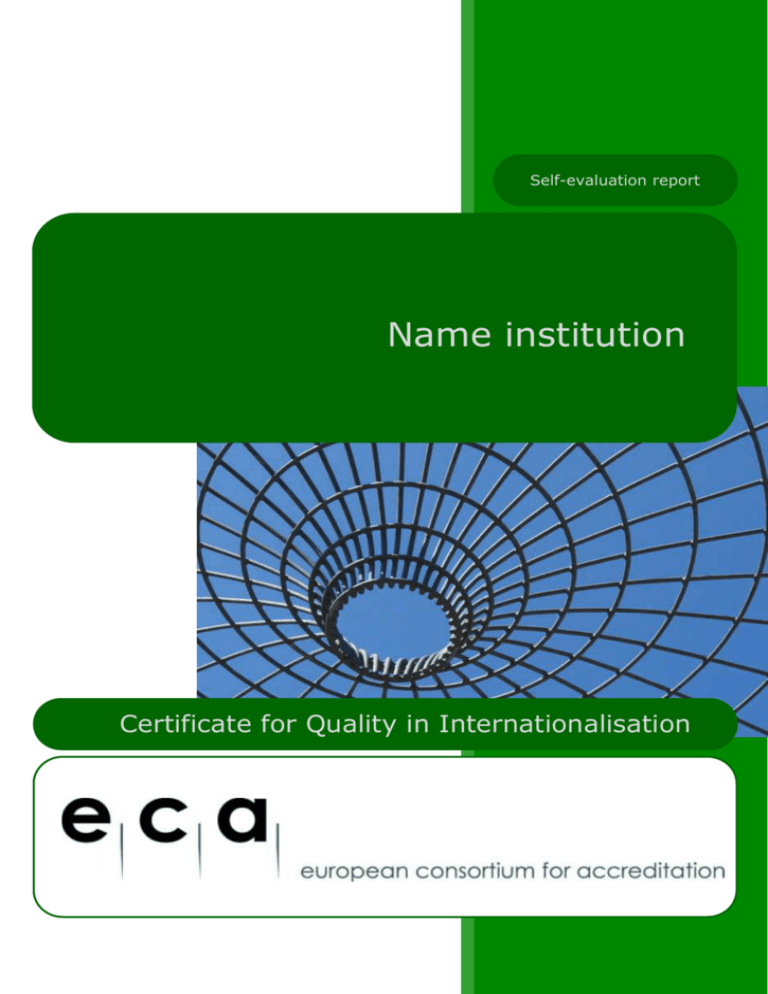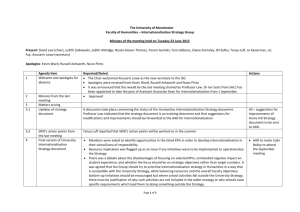
Self-evaluation report
Name institution
Certificate for Quality in Internationalisation
Self-evaluation report
- Institutional level
Copyright © 2013 European Consortium for Accreditation in higher education
ECA OCCASIONAL PAPER
ISBN/EAN: (TO BE FILLED IN ONCE PUBLISHED)
Author:
Axel Aerden
All rights reserved. This information may be used freely and copied for noncommercial purposes, provided that the source is duly acknowledged.
Additional copies of this publication are available via www.ecaconsortium.net.
This project has been funded with support from the European
Commission. This publication reflects the views only of the
author, and the Commission cannot be held responsible for any
use which may be made of the information contained therein.
4
Table of content
Preface ........................................................................................................................... 7
Glossary.......................................................................................................................... 9
1.
General overview .................................................................................................. 10
1.1.
1.2.
1.3.
Short introduction ................................................................................................ 10
Basic information ................................................................................................. 10
Mandatory annexes ............................................................................................. 10
2.
Assessment criteria for institutions ........................................................................ 11
3.
Concluding analysis ................................................................................................ 15
3.1.
3.2.
3.3.
Strengths in internationalisation ......................................................................... 15
Challenges in internationalisation........................................................................ 15
Opportunities and ambitions ............................................................................... 15
4.
References............................................................................................................. 16
5.
Annexes ................................................................................................................ 17
5
Preface
This template is made available to institutions intending to have the quality of their
internationalisation assessed. This template aims to facilitate the presentation of the
outcomes of the self-evaluation procedure on
institutional level and to make this information
easily accessible for the members of the
assessment panel.
The Standards and Guidelines for Quality
Assurance in the European Higher Education Area
(ESG) underline the importance of internal
A good self-evaluation report gives
the assessment panel the best
opportunity to
provide
feedback
recommendations
and
valuable
which go beyond the proceeds of a
normal quality assessment.
quality assurance and stress the fact that all
external quality assurance procedures should be
based on a self-evaluation procedure. A self-evaluation report is therefore an
indispensable element of any external quality assurance procedure.
The self-evaluation should be instrumental in establishing the institution’s strengths and
weaknesses. A good self-evaluation report provides insight into the critical reflection on an
institution’s quality and gives the assessment panel the best opportunity to provide
valuable feedback and recommendations which go beyond the proceeds of a normal
quality assessment.
The self-evaluation report should follow the outline depicted in section 2. Assessment
criteria for institutions. The outline can be amended where and if necessary, if this
improves the readability of the overall self-evaluation report.
For each of the standards, a presentation is expected of how your institution meets this
standard. If your self-evaluation indicates that this standard is not yet fully met, specify the
actions planned to remedy these specific weaknesses. The most important documents
referred to in the self-evaluation report should be attached as annexes to the selfevaluation report.
7
A self-evaluation report should not exceed 25 pages, excluding references and annexes.
We strongly encourage the use of existing texts and documents and not to produce much
new information. Preparing a self-evaluation report and undergoing a one-day site visit
does require some work, though. According to experiences with these types of
assessments in The Netherlands and Flanders, the total workload can vary between 120
hours (for well-prepared applicants with a smoothly functioning internal quality assurance
system) and up to 800 hours (in one case).
This preface and all the guidelines below should not be included in the final self-evaluation
report.
8
Glossary
Guideline: You should start your self-evaluation report with a glossary. Use a tab to
separate the abbreviation and the full text.
EHEA
European Higher Education Area
HE
Higher education
QA
Quality assurance
UAS
University of Applied Sciences
Etc.
9
1.
General overview
1.1. Short introduction
Guideline: An introduction gives the panel members a first impression of your
institution. You may briefly underline the importance of internationalisation for the
institution under evaluation.
1.2. Basic information
Institution:
...
Type of institution:
Status:
…
…
Guideline: Status refers to a status awarded to the institution by a quality assurance
(accreditation) agency or by a national authority.
QA / accreditation agency:
… (if applicable)
Status period:
… (if applicable)
Guideline: The period of validity of the current (accreditation/recognition) status can be a
period (from – until) but might also be just a starting or expiry date
1.3. Mandatory annexes
1.
2.
3.
4.
5.
6.
7.
8.
9.
10.
Guideline: Indicate by an X at the tick box that the document has been virtually
annexed. We expect to receive all documentation electronically.
The documented internationalisation goals;
Relevant (internationalisation) action plans;
Action plan regarding intercultural and international learning outcomes;
An overview of the institution’s international collaboration (e.g. institutional
networks, bilateral agreements, joint programme arrangements);
Table of incoming and outgoing students of the last three years (percentage
and absolute figures) per country and per type (credit or degree mobility);
Example of a Diploma Supplement;
Organisational chart;
Staff (policy) plan or similar document(s);
Quality assurance plan or similar document(s);
Summary of recent evaluation results and relevant management
information;
10
2.
Assessment criteria for institutions
Guideline: Address how your institution meets each of the criteria and do this in a clear
and concise manner under each of the boxed texts depicting the criterion. In addition,
refer where relevant to the documents providing evidence.
Guideline: Please keep the boxed criteria in the self-evaluation report for ease of
reading by the experts in the assessment panel.
Guideline: The standards and criteria included in the framework are assessed in the
context of the institution’s intended internationalisation. The framework does not
prescribe or endorse any particular internationalisation approaches or activities. The
institution’s intended internationalisation is therefore considered the appropriate
starting point for assessing its internationalisation. However, unambitious intentions
are not satisfactory. We consequently expect that an institution’s internationalisation
goals have an effect on the institution’s plans for action. Realisation of plans related to
internationalisation must, of course, be demonstrated. Internationalisation should,
additionally, be a basic element of the institutional quality assurance system. Finally,
institutional governance must prove to be enabling the coherent implementation of all
elements related to institutional internationalisation.
Standard 1:
Criterion 1a:
Intended internationalisation
Supported goals
The internationalisation goals for the institution are documented and these are shared and
supported by stakeholders within and outside the institution.
Criterion 1b:
Verifiable objectives
Verifiable objectives have been formulated that allow monitoring the achievement of the
institution’s internationalisation goals.
11
Criterion 1c:
Measures for improvement
As a result of periodic evaluations of the institution’s internationalisation, the successful
implementation of measures for improvement can be demonstrated.
Standard 2:
Criterion 2a:
Action plans
Fitness for purpose
The institution's internationalisation
internationalisation goals.
Criterion 2b:
plans
warrant
the
achievement
of
its
Dimensions
The institution's internationalisation plans include at least the following dimensions:
“international and intercultural learning outcomes”, “teaching, learning and research”,
“staff” and “students”.
Criterion 2c:
Support
The institution’s internationalisation plans are complemented by specific institution-wide
instruments and adequate resources.
Standard 3:
Criterion 3a:
Implementation
Information system
The institution has a functional management information system which enables it to collect
and process relevant information regarding internationalisation.
12
Criterion 3b:
Information driven
The institution makes use of processed information for the effective management of its
internationalisation activities.
Criterion 3c:
Realisations
The institution can demonstrate the extent to which its internationalisation plans are
realised through documented outcomes and results.
Standard 4:
Criterion 4a:
Enhancement
Internal quality assurance
The institution’s internal quality assurance system covers all internationalisation
dimensions and activities.
Criterion 4b:
Approaches for enhancement
The institution utilises internationalisation approaches as part of its regular quality
assurance and enhancement activities.
Criterion 4c:
Stakeholders involvement
The institution actively involves its internal and external stakeholders in its quality
assurance and enhancement activities regarding internationalisation.
13
Standard 5:
Criterion 5a:
Governance
Responsibilities
The responsibilities regarding the institution’s internationalisation (goals, plans,
implementation and enhancement) are clearly defined and allocated.
Criterion 5b:
Effectiveness
The organisational structure, decision-making processes and leadership (regarding
internationalisation) support the realisation of the institution’s internationalisation goals
and action plans.
Criterion 5c:
Responsiveness
The institution can demonstrate that it readily reacts to input from within and outside the
institution regarding internationalisation activities.
14
3.
3.1.
Concluding analysis
Strengths in internationalisation
Guideline: Briefly list your institution’s strengths regarding internationalisation. A short
bulleted list is expected; there is no need to expand.
3.2.
Challenges in internationalisation
Guideline: Briefly list your institution’s challenges regarding internationalisation. A
short bulleted list is expected; there is no need to expand.
3.3.
Opportunities and ambitions
Guideline: Briefly list your institution’s opportunities and ambitions regarding
internationalisation. Limit the list to short and medium-term ambitions. If possible,
refer to one or more appropriate standards. A short bulleted list is expected; there is
no need to expand.
15
4.
References
Guideline: Include the references to documents and material not annexed.
16
5.
Annexes
Guideline: Include the list of all the documents and material annexed. Where relevant,
replace the pro forma titles with the original names of the documents.
1.
The documented internationalisation goals;
2.
Relevant (internationalisation) action plans;
3.
Action plan regarding intercultural and international learning outcomes;
4.
An overview of the institution’s international collaboration (e.g. institutional
networks, bilateral agreements, joint programme arrangements);
5.
Table of incoming and outgoing students of the last three years (percentage and
absolute figures) per country and per type (credit or degree mobility);
6.
Example of a Diploma Supplement;
7.
Organisational chart;
8.
Staff (policy) plan or similar document(s);
9.
Quality assurance plan or similar document(s);
10.
Summary of recent evaluation results and relevant management information;
11.
…
12.
…
17
www.ecaconsortium.net
www.qrossroads.eu
www.ECApedia.net







